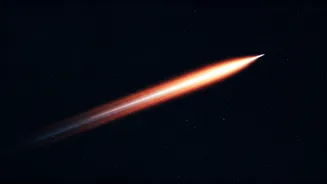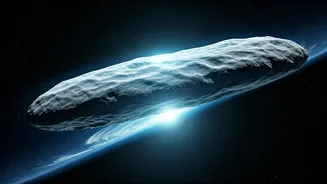Atlas's Intriguing Arrival
The interstellar object known as 3I/Atlas is currently on a trajectory toward the Sun, drawing the attention of astronomers worldwide. The presence of such
an object within our solar system offers a rare chance to study material from outside our own star system. This celestial body, unlike comets originating within the solar system, has a trajectory that indicates its origin lies far beyond, potentially from another star system. Scientists are using various instruments to study 3I/Atlas, aiming to gather information about its composition and physical properties. This study provides an unparalleled chance to observe and comprehend the building blocks of other planetary systems.
Compositional Analysis Underway
Scientists are deeply involved in understanding the composition of 3I/Atlas. This involves analyzing the light it reflects and emits to determine the presence of different elements and compounds. These observations help them understand what the object is made of, offering clues about its formation and the environment it came from. The analysis may reveal a rich mixture of materials, providing insights into the physical conditions under which it formed. Moreover, by comparing its composition with that of objects within our solar system and those found in other star systems, scientists hope to learn about the diversity of materials throughout the galaxy and the processes that shape them. This analysis will provide a valuable perspective of interstellar objects' nature.
Origins and Naming
The origin of 3I/Atlas, like all interstellar objects, is a topic of great interest. Scientists are using its trajectory and speed to trace its path back through the galaxy, seeking to determine its starting point. While the exact location of origin may remain elusive, examining its characteristics can provide clues. The name '3I/Atlas' follows the naming conventions used for interstellar objects. The '3I' denotes that it is the third interstellar object discovered, and 'Atlas' is an abbreviated name given by the scientists. This naming protocol helps in the systematic study and classification of such objects. The object's journey and discovery underscore the dynamic nature of space and the constant exchange of materials between star systems.
The Sun's Close Encounter
As 3I/Atlas approaches the Sun, scientists are closely observing how it reacts to the intense solar radiation and gravitational forces. This close encounter can alter the object's surface or even lead to the release of materials, forming a visible tail. Monitoring these changes helps scientists understand how interstellar objects interact with a star. The close passage can also allow for more detailed observations of the object's internal structure by analyzing how it responds to the Sun's gravity. The scientists will be able to estimate how the object can survive and what changes can happen to it. This analysis yields significant results for understanding the longevity and evolution of interstellar bodies.
Observational Opportunities
The visibility of 3I/Atlas from Earth varies depending on its brightness and position in the sky. Telescopes and observatories worldwide are tracking its progress, gathering data on its movement and changes. These observations provide a continuous stream of information, enabling scientists to study the object’s behaviour in real-time. The opportunity to observe an interstellar object offers invaluable learning moments to researchers. Even amateur astronomers with sufficient equipment can contribute to the ongoing monitoring efforts. This event offers opportunities to engage in scientific research and enhance our understanding of the universe.
Alien Technology Speculation
The nature of 3I/Atlas and its origin has naturally fueled speculation, including the possibility that it might be an alien probe or technology. While such ideas are intriguing, there is no scientific basis to support them. The object's properties have been studied and analyzed according to existing scientific methods and no evidence supports this theory. However, the possibility remains open as there are still many unexplored dimensions that may offer answers to many mysteries. Scientists are working diligently to gather more data and draw informed conclusions. The prevailing scientific view is to focus on objective observations and data-driven findings. The focus remains on understanding the origin and nature of 3I/Atlas through rigorous scientific study.
Black Swan Event
The term ‘black swan event’ is sometimes associated with celestial events, representing unexpected occurrences with significant consequences. While 3I/Atlas doesn't pose any immediate threat to Earth, the term serves as a reminder of the need for ongoing monitoring of celestial objects. This event allows scientists to continuously refine their understanding of potential hazards in space. This study enhances the overall preparedness for unforeseen astronomical phenomena. The focus remains on the importance of continued research and observation.











